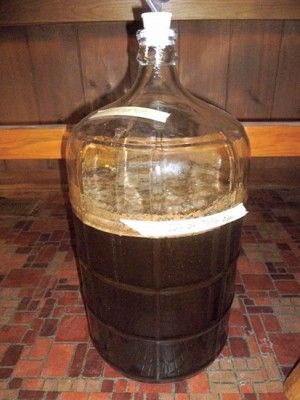Brewing Beer is More Fun With Company
There has probably never been a better time to take up home brewing; supplies and information are readily available at bricks-and-mortar stores and online
/https://tf-cmsv2-smithsonianmag-media.s3.amazonaws.com/filer/20111116100010Boiling-wort-beer.jpg)
I have found that one of the keys to harmony in my marriage is clear division of labor. I’m in charge of food acquisition and preparation (except one night a week, when my husband makes either pasta or pizza so I can write), paying bills, and general tidying. My partner is responsible for doing the dishes, most of the heavy housework (like cleaning the floors and bathrooms), and either mowing the lawn in summer or clearing the driveway of snow in winter. I’m pretty sure I got the better end of the bargain—here’s hoping he never develops an interest in cooking.
But sometimes it can be fun to tackle a kitchen project together, as we found this weekend, during our first attempt at brewing our own beer. After my last DIY food adventure, pickling vegetables from my garden, I was glad I didn’t have to go solo this time. As with the pickling, the process took a lot longer than expected—the better part of Sunday—but it went a lot more smoothly having two heads, and two sets of hands, rather than one.
Which is not to say there were no glitches. We followed a porter recipe from a nearby brewer’s supply store where we bought our ingredients. (There has probably never been a better time to take up home brewing—thanks to the explosion in interest in the past decade or so, supplies and information are readily available at bricks-and-mortar stores and online.)
The first step was to steep our specialty grains—a combination of three kinds of malted barley—in hot water, wrapped in cheese cloth like a giant tea bag. We accidentally spilled about a quarter of the grain in the sink while trying to pour it into the cloth. Everyone, from the supply store owner to the guys on the instructional video that came with our brewing kit to the authors of the book we bought on brewing, had drummed the importance of sanitation into my husband’s head. (After reading the book before bedtime, he actually muttered in his sleep, “It’s all about cleanliness.”) We didn’t dare try to salvage the spilled grain, even though the sink was clean. So we decided to compensate for the lost grain by steeping the remainder longer. I’m hoping we don’t end up with two cases of watery porter.
Next we added malt extract, which looks like the sludge left in an engine that’s overdue for an oil change but smells pleasantly, well, malty. This we boiled, along with the hops, for about an hour. Or, it would have taken an hour, if our 1961 stove weren’t so dysfunctional. The large front burner goes on strike about as often as an Italian train worker. At some point we realized our rolling boil had slowed to barely a simmer. And since the five-gallon pot wouldn’t fit on the back burner under the second oven, we had to move it to the small front burner. Again, we added a little extra time to compensate.

Finally we had our wort, which is what gets poured into the fermenter (a glass carboy) along with some yeast. At this point we would have used our hydrometer to measure the original gravity before fermentation—later readings will tell us how fermentation is going, because the reading will get lower as the sugars turn into alcohol—but we didn’t realize until too late that the hydrometer had shipped broken. The supplier sent out a new one and assured us it wasn’t a big deal to not get an original reading.
A couple of days later, our batch appears to be fermenting nicely; it has developed a good mound of foam on top, called Kräusen. By next weekend, it should be ready for racking, or siphoning into another carboy for secondary fermentation without the spent yeast sediment that has settled to the bottom of the first carboy. Once fermentation is complete, we’ll add a little corn sugar to aid carbonation before bottling.
By Christmas, we’ll either have two cases of delicious porter under the tree or 48 bottles to reuse/recycle and some brewing lessons under our belt. Either way, we’ll have a new hobby to share.
/https://tf-cmsv2-smithsonianmag-media.s3.amazonaws.com/accounts/headshot/Lisa-Bramen-240.jpg)
/https://tf-cmsv2-smithsonianmag-media.s3.amazonaws.com/accounts/headshot/Lisa-Bramen-240.jpg)